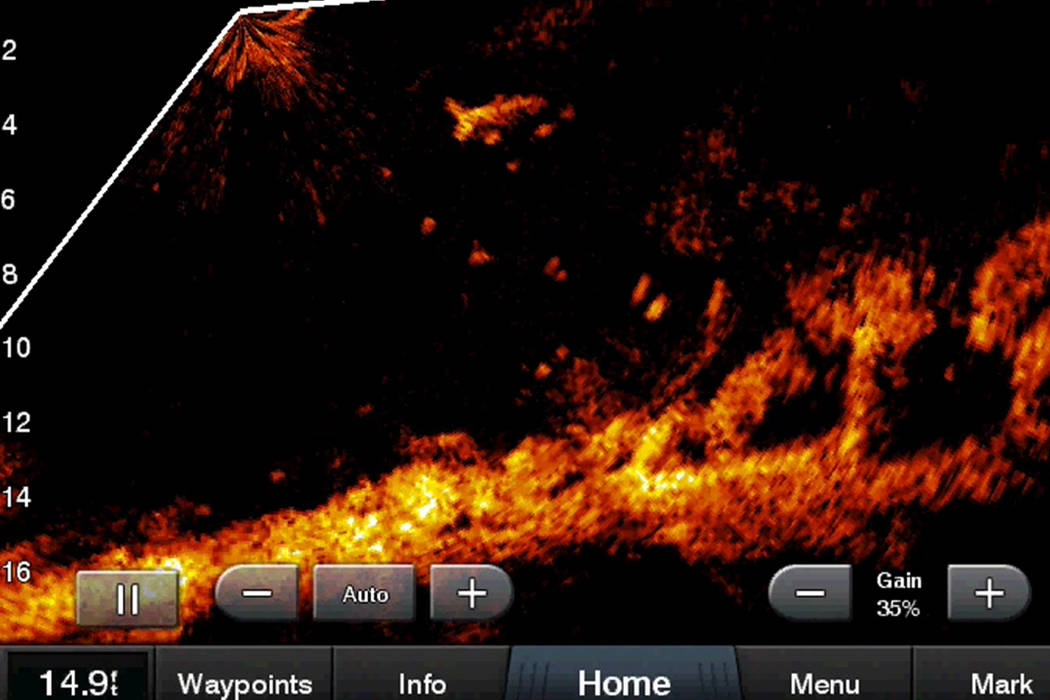Boat-mounted sonar units present challenges
One of the challenging things about using boat-mounted sonar units to locate game fish is trying to decipher the images on the fish finder’s display.
There are cloud-looking things, blips, dots, arches and sundry other marks. Not to mention a multitude of colors.
As a rule, the arches represent fish, but before you can identify what is a fish, you first must learn how to recognize the difference between a blip and an arch. That sounds easier than it really is, especially for newcomers who are often seen staring into the display on their fish finder while asking, “Is that mark a fish-representing arch or just an elongated blip? Or is it just the edge of a cloud looking thingy?”
Once an angler decides that a mark is definitely an arch, then he needs to identify the type of arch. Is it a largemouth bass? A catfish? Or maybe a carp?
This struggle has plagued anglers since the first fish finder showed up in stores and has not been overlooked by the companies who put them there. Through the years, these companies have spent millions of dollars looking for ways to improve the image you see on your fish finder’s screen.
One of those companies is Garmin USA, whose fish finding entry in the new products showcase at the International Convention of Allied sportfishing Trades walked away with the Best of Show Award. That recognition came after capturing the Best of Category Award for electronics.
ICAST is billed by the American Sportfishing Association as the world’s largest sportfishing trade show and was once a frequent visitor to Las Vegas. In recent years, however, the show has been in July in Orlando, Florida.
Garmin’s award-winning entry is sure to take the fun out of interpreting blips, arches and cloud-looking things. In fact, the Panoptix LiveScope offers anglers none of these. What it does provide anglers, according to a Garmin news release, is “the first and only live scanning sonar for recreational fishing.”
What does that mean?
It means when you look at the display on your fish finder you will see “easy-to-interpret scanning sonar images of structure, bait and fish swimming all around your boat, even when your boat is stationary.”
In other words, gone are the blips arches and cloud-looking things. There is no mistaking what you see on the screen. A bush is a bush, and a fish is a fish. And in some instances, you might be able to distinguish between fish species. You won’t be looking at a picture of a fish, but you won’t be left guessing, either. After watching a video of the LiveScope in action, it was hard not to be impressed.
During an interview with ICAST TV, the trade show’s in-house channel, Garmin pro angler Jason Christie said about LiveScope: “To me, as a fisherman, simpler is better. It’s really simple to use. The picture is 3-D. It makes my job a lot easier.”
LiveScope combines scanning sonar with live sonar, and that combination of technology accounts for the detail on your fish finder screen. The transducer offers two viewing modes, down and forward. Down shows you what is directly below your boat, and forward allows you to see all around your boat. In both modes, the viewing distance is about 200 feet.
To be sure that anglers see a steady sonar image, Garmin included what it calls an attitude heading reference system that compensates for a boat’s motion by constantly adjusting the unit’s sonar beams.
The LiveScope transducer comes with a universal plug that makes it compatible with several models of Garmin displays and chartplotters. You can expect to pay about $1,500 for the unit. Product videos and information can be found at garmin.com/panoptix.
Freelance writer Doug Nielsen is a conservation educator for the Nevada Department of Wildlife. His “In the Outdoors” column, published Thursday in the Las Vegas Review-Journal, is not affiliated with or endorsed by the NDOW. Any opinions are his own. Find him on Facebook at @dougwritesoutdoors. He can be reached at intheoutdoorslv@gmail.com.























